
Ganden Thangka Festival at Ganden Monastery
Summer is the typical festival season in Tibetan Buddhism, and the Ganden Thangka Festival is an important festival at the Ganden Monastery in Dagzê County of Lhasa. One of the Great Three university monasteries of the Gelug School of Tibetan Buddhism, the monastery was founded in 1409 by the founder of the Gelug order, Je Tsongkhapa.
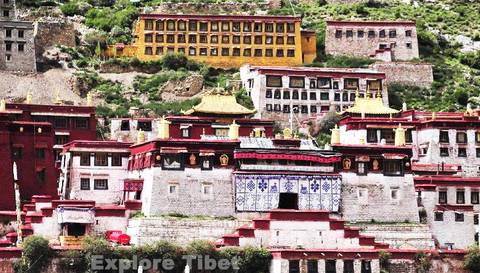
Ganden Monastery In Tibet
Dagzê County is located around 50 kilometers to the north of the city of Lhasa and lies in a hilly natural amphitheater, the edges of which form the kora route around the monastery. Lying on the top of the relatively small Wangbur Mountain inside this depression, the full name of the monastery, Ganden Namgyal Ling, means “joyful victorious temple”.
Table of Contents
A Brief History of Ganden Monastery
A visit to Ganden Monastery is worth taking, as it is the seat of the Gelug School. Gelug is actually an abbreviation of the original name of the order, which was known in the 15th century as Ganden Lug, which means “Ganden tradition”.
On the event of his death in 1419, Tsongkhapa gave his robe and staff to the first Ganden Tripa, the “throne-holder” of the Ganden Monastery, and these relics have been passed from Tripa to Tripa down through the centuries as part of the ritual of passing on the position within Ganden Monastery.
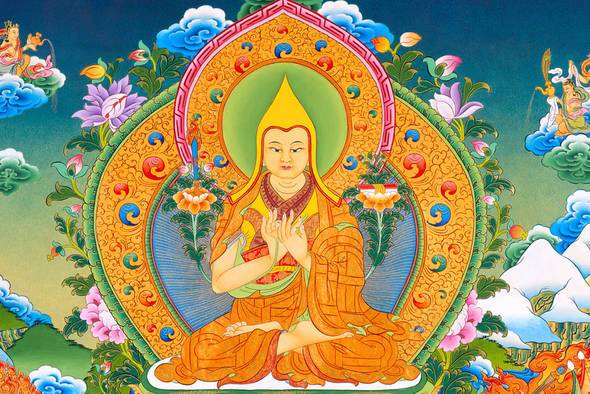
Je Tsongkhapa, The Founder of Gelug Tibetan Buddhist Sect
After his death, Je Tsongkhapa, the founder of the Gelug School, was preserved and interred in a tomb covered with gold and silver. Now a major shrine within the monastery, the tomb of Je Tsongkhapa is one of the sacred sites of Tibetan Buddhism.
The Ganden Thangka Festival
The Ganden Thangka Festival normally takes place in August of the Gregorian Calendar, or the 15th day of the sixth lunar month in the Tibetan Calendar. This year, the festival was held on July 27, 2018. With the spectacular views of the surrounding Kyichu Valley and the fascinating kora route that runs around the natural amphitheater, Ganden Monastery Thangka Festival is an experience unlike any other in Tibet.
During the festival, the monastery unveils a huge thangka on a wall outside the monastery, and thousands of people come to see the stunning painting and pray at the hem of the cloth. Thangka paintings are religious paintings in Tibet, where natural colors and dyes are used to paint a religious figure, usually either Buddha or one of the deities, on a massive piece of silk, which is then hung for all to see and pray at. Thangka painting is a dying art in Tibet, and there are few monks now that can create the quality and design that is needed for a true thangka.
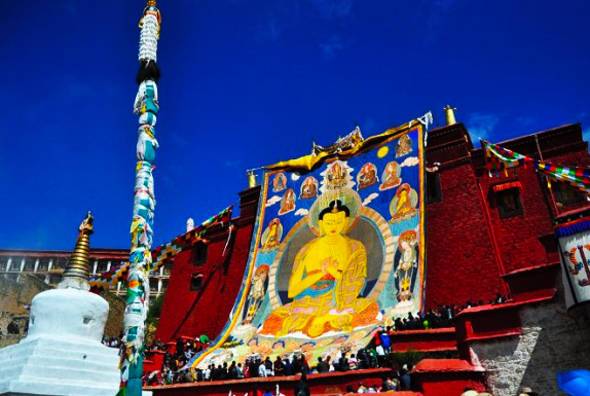
Gandan Thangka Festival In Tibet
On the day of the festival, the people arrive at the site very early in the morning, hoping to get the best place for viewing the thangka painting, and as close as possible so that they can be within the lucky few that will be able to touch the painting and pray at its hem. Some people will even walk hundreds of kilometers across the plateau to get to the monastery for the festival.
Decked out in their best traditional Tibetan dress, the scene on the hillside outside the monastery is one of fervent worship and devout Tibetan Buddhist belief. The day starts with an internal display in the monastery of the 25 holiest relics of the Gelug School of Tibetan Buddhism, which is normally kept locked away for the rest of the year, and are only brought out at special festivals. Some of the relics of Ganden Monastery are priceless and date back thousands of years.
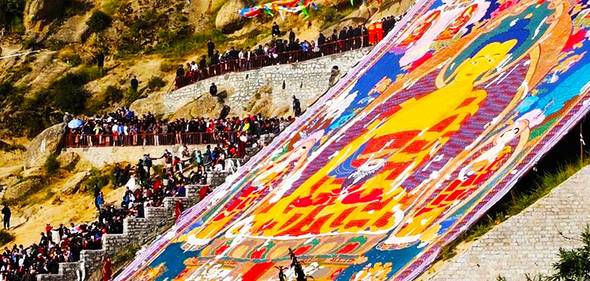
The Ganden Thangka Festival
As the people arrive, they perform the ritual kora around the monastery, then they enter the monastery’s great hall to view the statue of Buddha, pray, and be blessed by the lamas. The crowds of people wander from one temple to the next, making offerings of yak butter and receiving the blessings of the Buddhist monks, and the temples become a scene of colorful costumes and exotic sights, sounds, and smells.
On these festive occasions, Tibetans dress in their finest traditional dress, as well as dressing up their yaks, horses, and donkeys that are brought to the monastery. Once the offerings and prayers inside the temples are done, the crowds all disperse and head outside to sit and wait for the vividly-colored giant thangka to be brought out and unveiled.
Activities During the Festival
Thousands of people are spread across the slopes of Wangbur mountain, competing to get as close to the thangka as possible. As the younger monks march out of the monastery, horns start to blare, drums begin their beating, and the yellow-crested lamas start their trek from the monastery to the wall on the hillside, with the giant thangka rolled up and carried on their shoulders. Incense burns in piles on the hillside, enveloping the crowds in clouds of sweet-smelling smoke as the older monks and lamas take center stage, dressed in their finest robes, yellow horn-shaped hats topping their costumes.
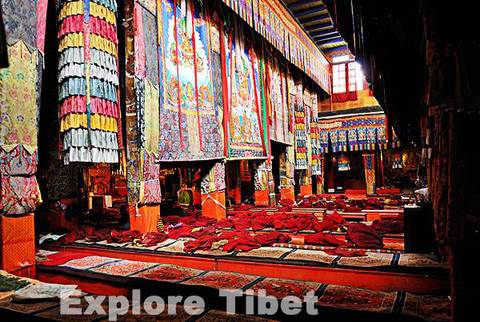
Ganden Monastery Prayer hall
As the lamas begin their prayers, the thangka is laid out on the wall, covered with a large cloth, and as the cloth is raised to reveal the giant thangka, the crowds cheer and pray fervently to the massive painting that covers the huge wall.
The thangka at Ganden Monastery that is unveiled every year stands around 60 meters wide and 40 meters tall and is an astounding sight, with its vivid colors and stunning design. Those closest to the thangka push forward to touch their foreheads to the hem of the painting in prayer and many throw the white Khada scarves onto the painting as a means of prayer.
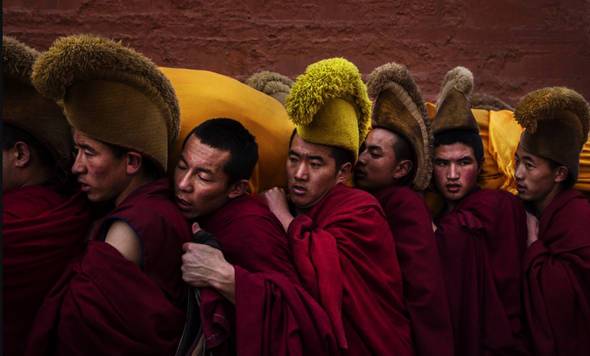
Monks carrying the Thangka on their shoulder during the Festival
As the monks bless the thangka with yak oil and prayers, the people pray devoutly and with the hypnotic beat of the horns and drums, the psychedelic colors of the thangka, and the intense smell of the incense smoke, it is like a scene from a strange dream.
Once the thangka prayers are over, after a couple of hours, the lamas recover and roll up the thangka, and carry it back into the monastery, to be stored away safely and carefully for another year.
However, that is not the end of the festival. As with all festivals in Tibet, it is a time for family gathering, and for eating and making merry. Once the thangka has been taken inside, the crowds disperse, heading to the slopes of the mountain or the lush grasslands within the natural depression, where they spend time eating and drinking with family and friends and playing light games.
Recent Posts
The three greatest monasteries of Tibet
Discover the Wonders of Tibet through Group Tours
Can Tourists Visit Tibet?
All Categories
- About Tibet
- book a Tibet tour
- Buddhism Practice
- Budget Tour
- China-Tibet Train
- Customized Tibet tour
- Historical Sites
- Hot Springs in Tibet
- News
- Photography in Tibet
- Tibet attraction
- Tibet Group Visa
- Tibet Motorcycle Tour
- Tibet Small Group Tours
- Tibet Tours and Tibetan Tour Guide
- Tibet Train
- Tibet Travel FAQs
- Tibet Travel Information
- Tibet Travel News
- Tibet Travel Permit Update
- Tibet Travel Prices Rises
- Tibet Trek
- Tibet Trekking Tour
- Tibet weather and climate
- Tibet Wildlife animals
- Tibet Winter Tour
- Tibetan Buddhism
- Tibetan Cultural Features
- Tibetan Culture and Poeple
- Tibetan Festivals
- What to see in Tibet


